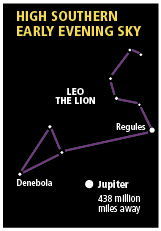Since last December, the mighty constellation Orion the Hunter has dominated the southern half of the evening sky, but times are a-changing.
Another bright and classic constellation perched high in the southeast evening sky, Leo the Lion, is pushing Orion and his posse of other bright winter stars and constellations toward the western horizon. You can see this push going on from night to night this month. And this year Leo has some added muscle with the mighty planet Jupiter residing among its stars near his hindquarters. The largest planet in our solar system is also the brightest star-like object in the evening sky this spring.
Actually it’s our Earth’s orbit around the sun that’s making this all happen. As our world continues its annual journey around our home star we’re turning away from the direction of space with Orion and the other winter constellations and facing toward the stars in and around Leo.
Leo is not quite as flashy as Orion, but it’s still distinctive and one of the brighter constellations. Most people see it as a two-part constellation. The right side is an easy to see backward question mark with the moderately bright star Regulus, the brightest star of Leo, marking the bottom dot of the query mark. It doesn’t take a whole lot of imagination to see how the sickle of stars outlines the profile of a lion’s head, with Regulus marking the heart of the giant heavenly feline. To the left of the lion’s bust is a triangle of moderately bright shiners that supposedly outline the lion’s derriere and tail.
Regulus, Leo’s brightest shiner, is certainly not in the upper echelon of bright stars in the night sky. In fact, Regulus is a Latin name that translates to the “little king” or “the prince.” Astronomically it’s not all that small of a star though. It’s nearly twice the diameter of our nearly million-mile-wide sun, and its interior nuclear fusion furnace is much more active than our sun. In fact, the outer layer of Regulus has a temperature of at least 20,000 degrees F, about twice as hot as our sun. That causes it to kick out 140 times more light than our home star. Regulus would be a whole lot brighter in our sky except that it’s 80 light years away, with just one light year equaling nearly six trillion miles. Denebola is the second brightest star of Leo at the tail of the celestial cat. The king of the planets, Jupiter, isn’t too far away from Regulus in the heavens right now. It’s not unusual to find planets in the vicinity of Leo the Lion. Leo is one of 13 constellations in what is called the zodiac band. Since Earth and the rest of the planets orbit the sun in nearly the same geometric plane, they are all found along this band of constellations that also lies along this plane.
Leo the Lion also has another visitor this weekend. It’s the waxing gibbous moon, gradually passing through the lower side of the constellation this weekend. In fact, tonight (Sunday) the moon will be parked just to the lower right of Jupiter to make for one heck of a celestial combo. Pray for clear skies, and don’t miss the show.
Mike Lynch is an amateur astronomer and professional broadcast meteorologist for WCCO Radio in Minneapolis and is author of the book, “Stars, a Month by Month Tour of the Constellations” published by Adventure Publications available at bookstores at http://www.adventurepublications.net
Talk to us
> Give us your news tips.
> Send us a letter to the editor.
> More Herald contact information.

























